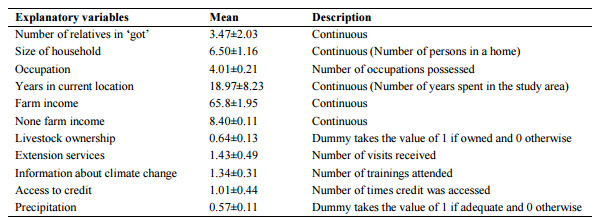Choice Options to Meet Household Food Security in the Cattle Corridor of Uganda
Main Article Content
Abstract
This study identified the major options adopted by households in the rangelands of Uganda to meet their food needs, the factors that affect their choices and barriers to making use of various choices. A cross-sectional survey using semi-structured questionnaires was administered among 180 pastoral households in selected rangeland area of Uganda. The options identified include restocking animals, changing planting dates, soil conservation, harnessing new technologies, planting trees and buying food stuffs. Analysis of results from the multinomial logistic model indicated that age, level of education, size of household, years in current location, farm income, non-farm income, livestock ownership, access to extension services and climate and weather information were key determinants of farmers’ choice of options to realize household food security. The major perceived barriers to choice options were lack of information on alternative options, poor technologies, climate variability, inadequate land, high food prices and low income. The analysis of choice of options to meet household food security suggests a number of different policy options such as strengthening production facilitation options available to pastoral communities including among others access to affordable credit, investing in yield-increasing technologies, introduction of livestock species that are better suited to drier conditions, raising awareness on climate related variations, creating opportunities for off-farm employment, encouraging pastoralists to grow more crops, and investing in irrigation.
Article Details
Published articles are under the copyright of the Environment and Natural Resources Journal effective when the article is accepted for publication thus granting Environment and Natural Resources Journal all rights for the work so that both parties may be protected from the consequences of unauthorized use. Partially or totally publication of an article elsewhere is possible only after the consent from the editors.

